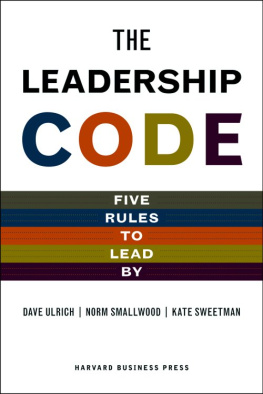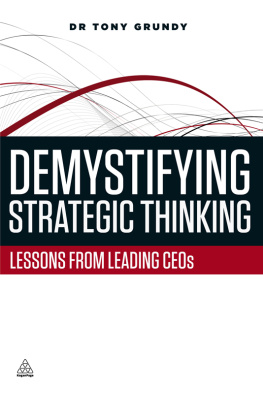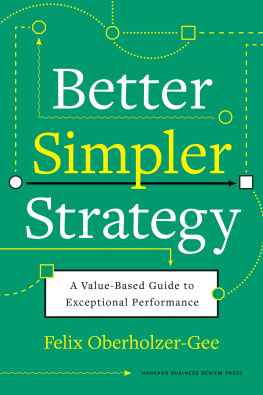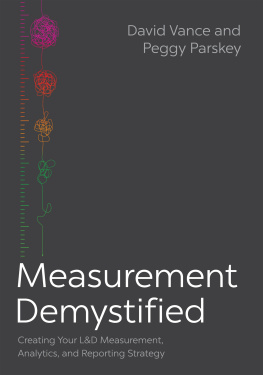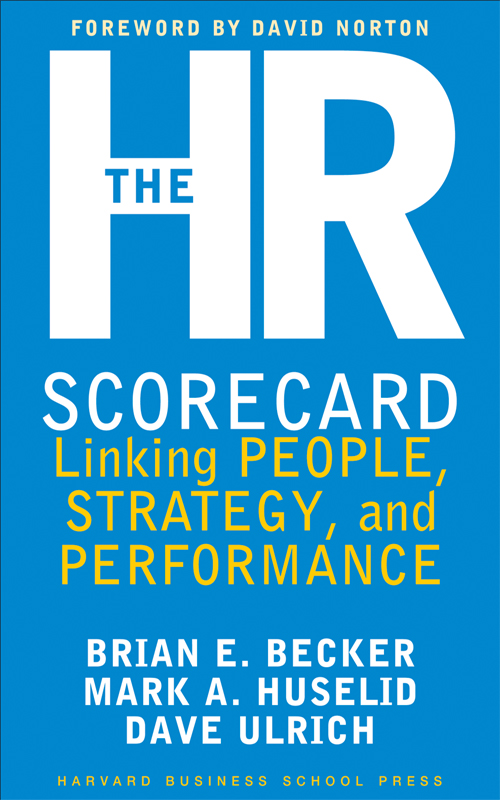Copyright 2001 President and Fellows of Harvard College
All rights reserved
First eBook Edition: February 2001
ISBN: 978-1-5785-1136-5
To Mary, Emily, and Ethan
To Rebecca, Rachel, and Robert
To Wendy, Carrie, Monika, and Michael
Since that time we, and our consulting organization, have had the opportunity to design Balanced Scorecards in more than200 companies. These designs always start with the same simple question, What is your strategy? This experience has givenus far reaching insights into the ways that executive teams think about strategy and their organizations. The typical executiveteam has a high degree of awareness and consensus around the financial strategy, as well as the priorities for operationalprocess improvement. They typically have limited consensus around customer strategies (i.e., who are the target segments,what is the value proposition), although this has improved in recent years. But the worst grades are reserved for their understandingof strategies for developing human capital. There is little consensus, little creativity, and no real framework for thinkingabout the subject. Worse yet, we have seen little improvement in this over the past eight years.
The greatest concern here is that, in the New Economy, human capital is the foundation of value creation. (Various studiesshow that up to 85 percent of a corporations value is based on intangible assets.) This presents an interesting dilemma:The asset that is most important is the least understood, least prone to measurement, and, hence, least susceptible to management.Clearly, we are at a watershed. As a new economic model ripples through the economy, a new science of management is needed.In an economy where value creation is dominated by human capital and other intangible assets, there can be no better startingpoint for this new science than with the measurement of human resource strategies. The HR Scorecard does just that and provides an important step forward in our ability to manage strategy.
Several facets of the book will make lasting contributions. First, the development of causal models, which show the relationship of HR value drivers with business outcomes, takes the Balanced Scorecard to the next level ofsophistication. Second, the research into the drivers of high-performance HR organizations gives executives a framework withwhich to build strategies for human capital growth. And finally, their insights into the competencies required by HR professionalslay the groundwork for an organization that can deliver on the promise of its measurement systems.
We cant manage something that we cant describe. Measurement is the language used to describe organizations and strategy.Through the frameworks, research, and cases encompassed in this work, the authors have given us a new generation of toolsto measure and manage the creation of human capital. The HR Scorecard should be essential reading for the New Economy manager.
DAVID NORTON
BOSTON, MASSACHUSETTS
PROFESSIONALS IN HUMAN RESOURCES are increasingly challenged to take a more strategic perspective regarding their role in the organization. We find that asHR professionals respond to this challenge, measuring HRs performance and its contribution to the firms performance consistentlyemerges as a key theme. This should come as no surprise. The last decade has been highlighted by an ever-increasing appreciationfor the value of intangible assets and the associated trend toward strategic performance measurement systems such as RobertKaplan and David Nortons Balanced Scorecard. New opportunities for HR professionals, new demands for HRs accountability,and new perspectives on measuring organizational performance have all converged. This book is intended to guide HR managersthrough the challenge of these converging trends. It is based on more than a decade of academic research on the HR-firm performancerelationship and grounded by our consulting work in a wide range of companies. The result is a new approach to managing afirms HR architecture (the sum of the HR function, the broader HR system, and resulting employee behaviors) as a strategicasset, as well as measuring its contribution to the firms performance.
Our work (some would call it an obsession) in measuring HR began with our efforts to try to understand whether, and if soby how much, this broader HR architecture contributes to firm success. Over the last decade we have collected data on HR managementquality from nearly 3,000 firms and have matched these data with employee turnover, productivity, stock market, and accountingperformance measures. Weve visited these companies, followed their performance over time, written cases about them, and subjected them to detailed statistical analyses. All of these activities have led us to the same broad conclusion: Firms withmore effective HR management systems consistently outperform their peers.
Yet, in our teaching and consulting work with executives we consistently confronted (and were confronted by) the same paradox:Evidence that HR can contribute to firm success doesnt mean that it is now effectively contributing to success in any given business. Managers (HR and line) have repeatedly challenged us with thequestion, Based on your research, how can I make HR a strategic asset in my firm?
We have come to believe that the capacity to design and implement a strategic HR measurement systemwhat we call in this bookan HR Scorecardrepresents an important lever that firms can use to design and deploy a more effective HR strategy. However, implementingeffective measurement systems is not easy; if it were, we would see a lot more of them. In addition, being held accountablefor results through measurement can be threatening. Many managers will avoid it if they can. But based on our experience,firms frequently underinvest in their peopleand, just as important, invest in the wrong ways. Moreover, many firms seem tobe unaware of the consequences of their investment decisions involving people. The most effective way we know to change thecalculus is to develop a measurement system designed to link people, strategy, and performance. This is what this book isintended to do.
ACKNOWLEDGMENTS
This project draws inspiration and wisdom from the efforts and support of many individuals. We are especially indebted toGarrett Walker, director of HR Planning, Measurement and Analysis at GTE (now Verizon), and Steve Kirn, VP for Innovationand Organizational Development at Sears. Garrett and Steve were very generous with both their time and their patience, providinga window into the best current work on HR measurement systems. The reader will also quickly recognize the intellectual debtwe owe to Bob Kaplan and Dave Norton. We have benefited not only from their work on balanced strategic performance measurement,but also from the passion and generosity with which they share those ideas. Brian Becker and Mark Huselid would also liketo thank Reed Keller and Bob Lindgren of PriceWaterhouseCoopers, LLC for their vision and enthusiasm about measuring HRsimpact on firm performance. They displayed a confidence in these ideas, and in us, at a time when these ideas werent very well accepted.
Our work has also benefited immensely from the influence of a wide variety of colleagues. We would particularly like to thankJane Barnes, Dick Beatty, Wayne Brockbank, Susan Jackson, Steve Kerr, Jeffrey Pfeffer, and Randall Schuler for their abilityto frame the issues about measurement and their willingness to debate these ideas and share their insights. Carol Tutzauersfamiliarity with the Galileo program was an essential contribution to .



